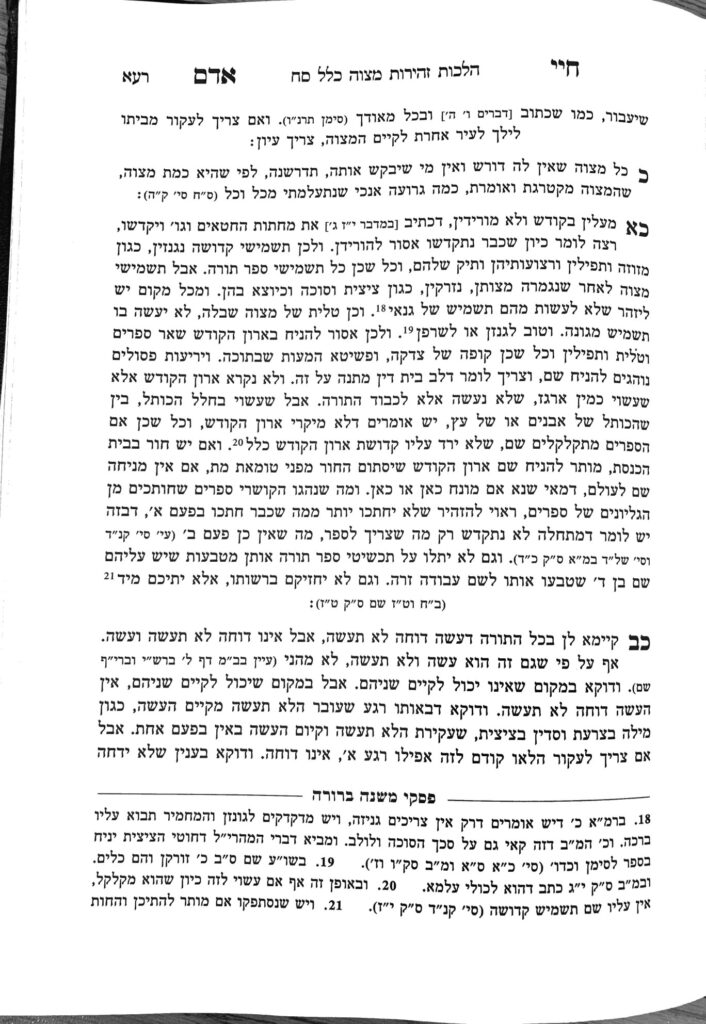We are continuing in siman 21, discussing the halachos of geniza. Sometimes, an announcement will be put up with a pasuk on it, such as an announcement that a certain person is mechalel Shabbos so business should not be done with them, an announcement that it is assur to smoke on Yom Tov, or a reminder to make an eruv tavshillin. If the purpose of the announcement is to teach divrei Torah, such as an issur to smoke on Yom Tov, the announcement falls under divrei Torah and would require geniza. If the purpose is to simply give over a directive, such as a reminder to make an eruv tavshillin, or not to do business with someone, it does not require geniza.
Another example would be a food package which states the bracha of the food. If only the bracha is printed on the packaging, it does not require geniza, but if the packaging explains why one should make that particular bracha, it is now serving to teach divrei Torah and would require geniza.
Sometimes Jewish calendars will include divrei Torah. If the purpose is to learn different halachos related to the year, it would require geniza, but if it is just to remind people about relevant instruction for the various yamim tovim, or if pesukim are used in a flowery way not for the purpose of teaching Torah, it would not require geniza.
If a person is learning, and draws illustrations to help understand the Gemara, there is no kedusha to the illustrations, unless they write the words of the Gemara to accompany the illustrations. Similarly, if a person writes mareh mekomos, there is no kedusha involved with them, but if they begin to quote the piece, it would require geniza.
We learned about the issur of erasing Hashem’s name. Regarding a computer screen with Hashem’s name, or even with divrei Torah, the assumption of the poskim is that we do not consider the screen to be writing. Although it may appear to be writing to our eyes, it is just a makeup of many dots. Since it does not have the status of writing, there is no issur to erase it.
Tapes or disks do not have a chiyuv geniza. However, they should not be thrown out in a manner of bizayon, so they should be wrapped before being placed in the garbage.
Regarding the box a sefer comes in, if the box serves to enhance, decorate or protect the sefer, it is considered a tashmish kedusha, and has a chiyuv geniza. If the box serves only to facilitate transportation or storage, there is no chiyuv geniza.
These halachos apply not only to divrei Torah written in lashon hakodesh, but to any other language as well. There is an interesting discussion regarding braille. Rav Elyashiv paskened that there is a chiyuv geniza on braille as well, because it is a form of writing for those who need it.
Summary
- An announcement, paper or package which states a halacha for the purpose of informing or directing people does not require geniza. If its purpose is to teach about the halacha, or if there is an explanation about the halacha, it would require geniza.
- Illustrations to understand a Gemara or mareh mekomos do not require geniza, unless one quotes the text.
- There is no issue with erasing Hashem’s name or divrei Torah on a computer screen.
- Tapes or disks do not have a chiyuv geniza, but should be wrapped before being thrown out.
- If the box of a sefer serves to enhance the sefer, it requires geniza. If it is only for the purpose of transportation, it does not require geniza.
- Divrei Torah require geniza regardless of the language they are written in.
- Braille requires geniza.



